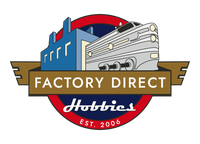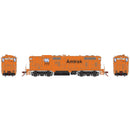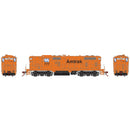In the late 1970’s Amtrak acquired a fleet of second-hand GP7’s which were painted in a bright orange color for use in maintenance-of-way service (MOW). These highly visible units were quickly and unofficially named “Pumpkins” by the railfan community. They were frequently spotted hauling Amtrak ballast cars, flat cars equipped with special racks to carry rail, or gondolas that were used to gather scrap steel and wooden ties that accumulated on the right-of-way. Aside from MOW use, these units were used to couple Amtrak express Roadrailers to soon-to- arrive passenger trains. Pumpkins could also be found in service on non-Amtrak rails. For example, Amtrak “Pumpkins” were involved in the rebuilding of the Doylestown branch for the Southeastern Pennsylvania Transit Authority (SEPTA), and the Atlantic City line for New Jersey Transit. This bright paint scheme with unique details such as cab mounted strobes and end mounted emergency beacons will surely be an “attention grabber” on your layout.
AMTK FEATURES: • NEW! Non-Dynamic with roof access hatches • 1700-gallon fuel tank • Partial skirting above fuel tank • Front and rear flashing emergency beacon (in DCC mode only) • Flashing xenon strobes (in DCC mode only) • Wheel bearings per prototype
GP7 SERIES LOCOMOTIVE FEATURES:
- Coupler cut levers
- Trainline and MU hoses
- Drop steps unless noted
- MU stands
- “Nub” style walkway tread
- Windshield wiper
- Lift rings
- Wire grab irons
- Windshield wipers
- Sander lines
- NEW! Roof access hatches on non-dynamic units per prototype
- Bell placement & type per prototype
- Detailed fuel tank with fuel fillers, fuel gauges, breather pipes, and retention tanks
- Blomberg-B trucks with appropriate bearing caps
- Speed recorder unless noted
- See-through cab windows and full cab interior
- Fine-scale Celcon handrails for scale appearance
- Etched metal radiator intake grilles and fan grilles
- Air tanks mounted below sill unless noted
- Body-mounted McHenry® scale knuckle couplers - Kadee® compatible
- DCC-ready features Quick Plug™ plug-and-play technology with 21-pin NEM connector
- Scaled from prototype resources including drawings, field measurements, photographs, and more
- Accurately painted and printed paint schemes
- Genesis driveline with 5-pole skew wound motor, precision machined flywheels, and multi-link drivetrain
- All-wheel drive with precision gears for smooth & quiet operation
- All-wheel electrical pickup provides reliable current flow
- Wheels with RP25 contours operate on all popular brands of track
- LED Lighting for realistic appearance
- Heavy die-cast frame for greater traction and more pulling power
- Packaging securely holds for the model for safe storage
- Minimum radius: 18”
SOUND-EQUIPPED MODELS ALSO FEATURE:
- Onboard DCC decoder with SoundTraxx Tsunami2 sound
- Dual cube speakers for optimal sound quality
- Sound units operate in both DC and DCC
- Full DCC functions available when operated in DCC mode
- Engine, horn, and bell sounds work in DC
- All functions NMRA compatible in DCC mode
- Precision slow speed control
- Program a multiple unit (MU) lashup with lead unit only horn, bell, and lights
- Many functions can be altered via Configuration Value (CV) changes
- CV chart included in the box
PROTOTYPE AND BACKGROUND INFO:
In 1949, EMD introduced the GP7. The basic design followed most diesel switchers with the addition of a short hood instead of an end-cab. The hoods were also full height to better accommodate the diesel engine and mechanical and electrical components.
Many railroads chose to rebuild their GP7s and GP9s for continued service. Often times, it was cheaper to do this rather than purchasing brand-new locomotives. Some railroads adopted a GP7R designation to indicate a rebuilt unit.





